VOICE ONE:
I'm Bob Doughty.
VOICE TWO:
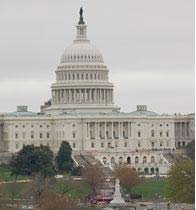
And I'm Faith Lapidus with EXPLORATIONS in VOA Special English. The United States Capitol in Washington, D.C., is one of the most recognized buildings in the world. Its design was influenced by the classical buildings of ancient Greece and Rome.
The United States Congress meets in the Capitol. The building was created as a physical representation of democracy. But it is also a museum filled with art and sculpture that tell about America's social and political history.
(MUSIC)
VOICE ONE:
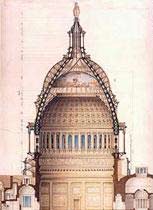
Our story begins on the Caribbean island of Tortola during the hot summer of 1792. William Thornton is hard at work on a set of building drawings. Mr. Thornton came from a family of wealthy landowners who grew sugar on the island. He was trained as a doctor. But he had many interests including history, mechanics, government and building design. Mr. Thornton was working to complete drawings for the design of the United States Capitol.
VOICE TWO:
A few months earlier, the government of President George Washington had started a contest for the best design for the Capitol. William Thornton wanted the building to express the democratic goals of this young country. It would be a physical version of America's constitution. His design was influenced by the Parthenon in Rome, Italy and the Louvre museum in Paris, France.
William Thornton sent his building design to federal officials in Washington with a letter. "I have made my drawings with the greatest accuracy, and the most minute attention", he wrote. "In an affair of so much consequence to the dignity of the United States," it was his request that "you will not be hasty in deciding."
President Washington and Secretary of State Thomas Jefferson selected a later version of Mr. Thornton's design for the Capitol. George Washington praised the design for its "grandeur, simplicity, and beauty."
(MUSIC)
VOICE ONE:
Over the centuries, the United States Capitol has had many changes and additions. Many architects have worked on its extensions. But just as important as the building's design are the priceless collections of art and sculpture inside. They tell a detailed story about different events in America's past. And, they provide an interesting commentary on how America's government, people, and artists have chosen to represent their history.
We asked Barbara Wolanin to take us through several important rooms to learn more about the building's art and statue collection. She is the curator for the Architect of the Capitol.
BARBARA WOLANIN: "The Capitol, from the very beginning, the architects envisioned art sculpture for it, paintings for it. They were really built in as part of the architecture in each of the different construction stages of the Capitol."
(SOUND)
VOICE TWO:
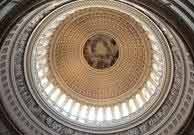
We start in the most beautiful room, the Rotunda. This large circular room inside the Capitol's tall white dome measures over 54 meters high. It was completed in 1824.
The room connects the Senate side of the building with the House of Representatives side. So, it is both the physical and symbolic center of the building. Visiting the room is a wonderful experience. The room has a feeling of solidity and permanence, but it also is a celebration of light and airiness.
BARBARA WOLANIN: "We're in the Rotunda, right in the center of the United States Capitol, and starting from the top down, the very top is the fresco painting called the "Apotheosis of Washington". It was painted by a Roman-born artist Constantino Brumidi in 1865, at the end of the Civil War."
VOICE ONE:
At the top of the dome is a colorful painting showing groups of people arranged in a circular shape. George Washington sits in the center of the painting, with women representing Liberty and Victory at his sides.
BARBARA WOLANIN: "He's the one in the lavender lap robe. And he's rising up into the heavens. Apotheosis means being raised to the level of an ideal or a god."
VOICE TWO:
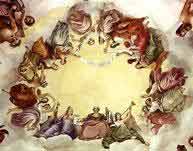
It might seem strange today to show an American president as a god. But during the 19th century, Americans greatly loved and respected President Washington. This included Americans from both the North and South after the Civil War. Several Roman gods are also in the painting. They are holding examples of American technologies of the time.
BARBARA WOLANIN: "They are mixed in with new American technology, the latest inventions. Like Ceres there is sitting on a McCormick reaper, which is the new way for reaping grain quickly. And Neptune with a Trident is helping lay the trans-Atlantic cable which was just being laid when he was painting this."
VOICE ONE:
The artist Constantino Brumidi finished this huge work in only eleven months. He also painted much of the frieze that extends along the Rotunda walls under the room's 36 windows. A frieze is a long stretch of surface that has been painted or sculpted. This one tells the history of America. The people in the frieze are painted to look three-dimensional, like sculptures.
Below the frieze, eight huge historical paintings hang on the curved walls. Four paintings tell about the events of the Revolutionary War in the late 18th century. The four others show examples of early explorations of the country. These include the landing of explorer Christopher Columbus and the discovery of the Mississippi River.
VOICE TWO:
Sculptures are another important part of the room's decoration. One marble sculpture of Abraham Lincoln was created in 1871, after his death. Vinnie Ream made the sculpture. She was the first woman hired by the government to create a work of art. She was only 18 years old when she was asked to make the statue.
Another marble statue nearby honors three women who fought for voting rights for women. Adelaide Johnson made this sculpture.
BARBARA WOLANIN: "'Portrait Monument' has just an amazing history too. This is also by a woman artist. And it was commissioned by the National Woman's Party in 1920 after women finally got the vote."
VOICE ONE:
The sculpted forms of Elizabeth Cady Stanton, Susan B. Anthony and Lucretia Mott seem to be coming up out of the huge piece of stone.
Behind them, a fourth form rises out of the uncut stone. Adelaide Johnson said this unfinished area was meant to show that the struggle for women's equality was not over.
(MUSIC)
VOICE TWO:
Many of the statues in this room and others throughout the Capitol are part of the National Statuary Hall Collection. The collection was established in 1864. Congress invited each state to send two statues to the collection.
The statues can represent a very famous person, such as an American president. Or, they can represent someone less well known but historically important. States can also replace an older statue with a new one. It has taken a long time to complete the collection. The 100th statue arrived in 2005.
VOICE ONE:
Barbara Wolanin takes us into the National Statuary Hall. This large room was a meeting room for the House of Representatives until 1857.
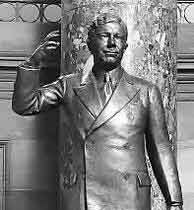
BARBARA WOLANIN: "This room, at the time it was built was considered the most beautiful room in the whole country. Benjamin Henry Latrobe was the architect and he really tried to make it as fine as he could. He was very interested in the classical architectures. So he wanted columns and he had these special capitals for the columns carved in Carrara, Italy based on ancient designs."
As you can guess from the room's name, it now houses many statues from the national collection. For example, there is a marble statue of Sam Houston, a leader who fought for independence for the state of Texas. One of the state of Louisiana's statues is a bronze representation of the politician Huey Long.
VOICE TWO:
The newest building extension of the Capitol is the Capitol Visitor Center. These large underground rooms were completed in December of 2008. The goal is to enrich the experience of the more than two million people who visit the Capitol every year.
The Visitor Center is filled with water fountains, skylights, historical exhibits, a restaurant — and more statues. A bronze statue of the Hawaiian ruler King Kamehameha is hard to miss. His clothing is almost completely covered in gold. Every year in June, Hawaiians come to the Capitol to honor this ancient ruler.
VOICE ONE:
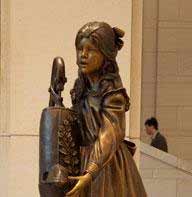
The newest statue in the national collection is from Alabama. It shows the deaf and blind activist and writer Helen Keller as a young child. It is also the smallest statue in the collection.
But the biggest statue in the room is not part of the Statuary Collection. It is a plaster form that was used to make the bronze statue of Freedom that stands on the dome of the Capitol high above the city. Freedom is represented as a strong woman wearing the flowing clothing of ancient Rome. She measures over five meters tall.
If you stand under a skylight in the Visitor Center, you can see the bronze statue of Freedom high up on the dome outside. She is watching over the Capitol building as it continues to represent America's history, government and people.
(MUSIC)
VOICE TWO:
This program was written and produced by Dana Demange. I'm Faith Lapidus.
VOICE ONE:
And I'm Bob Doughty. Next week, we visit another important art collection, at the Vatican in Italy. You can comment on this and other programs on our Web site, voaspecialenglish.com. Join us again next week for EXPLORATIONS in VOA Special English.
apotheosis: a formal statement that a person has become a god (指人)册封为神,尊奉为神,神化
lap robe: a blanket or fur piece for covering the lap, legs, and feet, as of a passenger in an unheated car or carriage 盖膝的毯子
frieze: a border that goes around the top of a room or building with pictures or carvings on it 檐壁(有浮雕或其他装饰)
Shakespeare was a producer and actor and, oh yes, a writer
Eleanor Creesy: she guided one of the fastest sailing ships
Visiting the Galapagos and the unusual creatures that live there
Cliffhanger: rock climbing as sport and art
(来源:VOA 编辑:陈丹妮)
